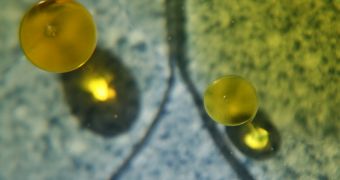A simple experiment produces some puzzling results and no scientific explanation for the phenomenon has been found until recently. This one can be safely performed at home and you don't need expensive equipment.
First you must pour clean water onto a small, almost flat, plate. No need for distilled water, as regular water will do just fine. Then, in a ball, mix small amounts of mineral oil with just a tiny drop of detergent.
Then take a drop of the mixture and pour it into the water. The oil will start pumping like a beating heart, with no apparent reason or driving force. It may be simple and easy to observe, but this effect has been puzzling scientists for quite some time, as it was first documented by Benjamin Franklin, in 1774.
Only recently, MIT Professors Roman Stocker of civil and environmental engineering and John Bush of mathematics, came up with what seems to be a valid explanation for what makes an oil drop containing a water-insoluble surfactant - a material that allows oil to spread easily but reduces its surface tension - to throb on a water surface.
"It's an easy experiment to make. But getting the theory for it was not straightforward," Bush said. "Roman turned a microscope loose on the problem--which was key to finally understanding it."
As some of you may already suspect, surface tension is the mechanism involved. To be exact, the evaporation-induced variations in surface tension produce consecutive expansions and contractions of the drop, about once every two seconds, until it runs out of surfactant.
This explains prior observations showing that covering the experiment stops the process. In fact, this prevents evaporation of the surfactant. "We're dealing with three interfaces: between the oil drop, the water in the Petri dish, and the air above it," Stocker said, explaining surface tension. "A detergent is a surfactant, which reduces the surface tension of a liquid. The detergent molecules we added to the oil drop prefer to stay at the interface of the oil and water, rather than inside the oil drop."
The oil-detergent mixture looks like a lens, thicker at the bottom, where more surfactant settles, which reduces surface tension and causes the oil and surfactant near the outer edges of the drop to circulate. A shear action is produced by this circulation, thus generating very tiny waves rolling outward toward the edge.
When the waves get near the edge, small droplets erupt and head for the water surface outside the drop itself, where they disperse in water, decreasing surface tension to make the drop contract. Then they evaporate, increasing again the surface tension, in a repetitive process.
This explanation could have practical applications in fields from biology to environmental engineering.

 14 DAY TRIAL //
14 DAY TRIAL //